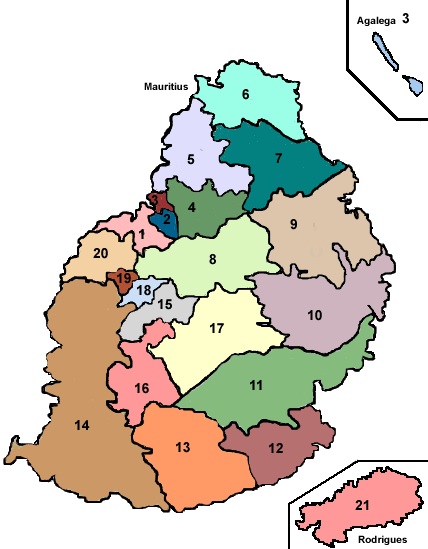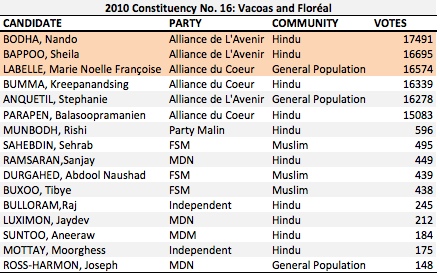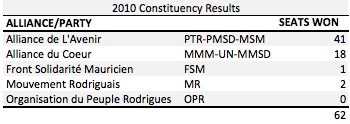The Mauritian National Assembly has 70 seats with 62 allocated by the block vote system within multimember electoral constituencies. The remaining 8 are distributed by the country’s unique best-loser system designed to assure ethnic balance without altering significantly the balance of power between parties resulting from the constituency elections.
Constituency Mandates
Mauritius has 21 constituencies–20 on the island of Mauritius elect 3 MPs while the sole constituency on Rodrigues elects 2 MPs. Voters must cast as many votes as there are seats in the constituency in order for their ballot to be valid (i.e. bullet voting is prohibited). However, they may cast votes for candidates from different parties or coalitions. The candidates with the most votes will the constituency seats. Here is a map of the 21 electoral constituencies:
 Best-Loser System
Best-Loser System
The allocation of best-loser seats is designed to render the ethnic balance more closely resemble that of the 1972 Census without altering the seat margin held by the party with the most seats over other parties. Mauritius divides its population into four communities: Hindu, Muslim, Sino-Mauritian, and the General Population. This last group is comprised mainly of African Creoles and Franco-Mauritians.
Each candidate for a constituency seat must identify themselves as a member of one of the four communities prior to the election. Their self-designation may be challenged by any elector with adjudication by the Supreme Court.
After the election, the allocation of the best-loser seats to each of the four ethnic groups is determined using the d’Hondt system. The d’Hondt quota for each group is calculated by dividing its 1972 population by the number of seats already won plus one. The seats are then allocated to the groups with the highest quotas (with a group having its quota recalculated each time it receives a best-loser seat based on its new seat total).
The first 4 of the 8 seats are distributed to the most successful losing constituency candidate of the appropriate community regardless of party (but must have run with a party rather than as an independent). “Most successful” is defined as the losing constituency candidate of the appropriate group who received the highest percentage of the vote in their constituency.
The allocation of the last 4 best-loser mandates takes into account party as well as community. In order to allocate these seats, one must first determine how many of the first 4 best-loser seats went to parties other than the party that won the most constituency seats. The party that won the most constituency seats then receives as many best-loser seats as were already awarded to other political parties. These seats go to the most successful unreturned candidates of the leading party who belong to the appropriate community.
If any best-loser seats still remain, there are further allocation rules. The next best-loser seat goes to the most successful unreturned candidate of the appropriate community who belongs to the party that received the most seats and has not yet received any best-loser seats–if any candidate meets all of these requirement. If any still seats still remain, this process is repeated for the next most successful party that has yet to receive best-loser seats until there are no more seat-winning parties.
If any best-loser seats still remain, the next mandate goes to the most successful unreturned candidate of the appropriate community who belongs to the party with the second most constituency seats. If any seats still remain, the process is repeated for the party with the next highest number of constituency seats until there are no more seat-winning parties.
It may not be possible to allocate all 8 best-loser seats. For example, if the leading party’s candidates sweep all of the constituency seats, then it has no losing candidates. Accordingly, the first four best-loser seats will go to other parties. But then there will be no candidates from the leading party to receive the final four constituency seats because it has no unreturned candidates. The allocation stops at this point since it is not possible to restore the original seat margin held by the leading party. Although the leading party’s seat margin in the National Assembly would decline by four, it would still hold an overwhelming share of seats.
Allocation Example
The first table presents the results from Constituency 16 (Vacoas and Floréal) in 2010. It’s on the island of Mauritius, so it elects three members. The three candidates who received the most votes, highlighted in orange, were elected.
 Here is total the number of constituency seats won by each alliance or party in 2010:
Here is total the number of constituency seats won by each alliance or party in 2010:
 The next step is to allocate the best loser seats. The following table shows the number of constituency seats won and the 1972 Census population for each of the four recognized communities. The d’Hondt quotas used to determine the order of allocation of the 8 best-loser seats to each community are equal to the 1972 Census population divided by the number of seats already won by the community plus 1, and are shown below. The boldface numbers to the left of the quotas indicate the allocation order.
The next step is to allocate the best loser seats. The following table shows the number of constituency seats won and the 1972 Census population for each of the four recognized communities. The d’Hondt quotas used to determine the order of allocation of the 8 best-loser seats to each community are equal to the 1972 Census population divided by the number of seats already won by the community plus 1, and are shown below. The boldface numbers to the left of the quotas indicate the allocation order.
 The final table shows the names of the candidates awarded best loser seats. The first 4 seats were distributed without regard to party and went to the most successful unreturned candidate of the appropriate community. Most successful is defined in terms of the share of votes won by a candidate in their constituency.
The final table shows the names of the candidates awarded best loser seats. The first 4 seats were distributed without regard to party and went to the most successful unreturned candidate of the appropriate community. Most successful is defined in terms of the share of votes won by a candidate in their constituency.
 After the award of the first 4 seats, the leading party in terms of seats is entitled to receive as many best-loser seats as won by other parties among the four four best-loser seats. The Alliance de L’Avenir, the winner of the elections, was awarded the 3 next best-loser seats as it gained only 1 of the first 4 best-loser seats. Again, these mandates went to unreturned candidates of the appropriate community with the highest share of the vote in their constituency.
After the award of the first 4 seats, the leading party in terms of seats is entitled to receive as many best-loser seats as won by other parties among the four four best-loser seats. The Alliance de L’Avenir, the winner of the elections, was awarded the 3 next best-loser seats as it gained only 1 of the first 4 best-loser seats. Again, these mandates went to unreturned candidates of the appropriate community with the highest share of the vote in their constituency.
The final seat was to go to a Sino-Mauritian but could not be allocated. The rules indicate that the seat should go to party with the most seats that has not yet received a best-loser seat. However, the Mouvement Rodrigues (MR) had no losing Sino-Mauritian candidates. Similarly, the Front Solidarité Mauricien (FSM), the only other party that had won seats but not received a best-loser seat, also had no losing Sino-Mauritian candidates.
The rules then indicate that, if possible, the seat should go to the party or alliance with the second (or if that is not possible, the third, fourth, and so on) highest number of seats. But the Alliance de Coeur also had no losing Sino-Mauritian candidates. The third place party in terms of seats is the MR and the fourth place party is the FSM, which already could not gain the seat in the previous stage due a lack of losing Sino-Mauritian candidates.
At this point, all of the possibilities for awarding the seat under the rules were exhausted and the eighth best-loser seat was not allocated to any candidate.
Change to Best-Loser System in 2014
Starting in 2014, candidates could opt not to declare an affiliation with one of the four recognized communities. However, candidates who do not declare a community affiliation are ineligible for best-loser seats.
